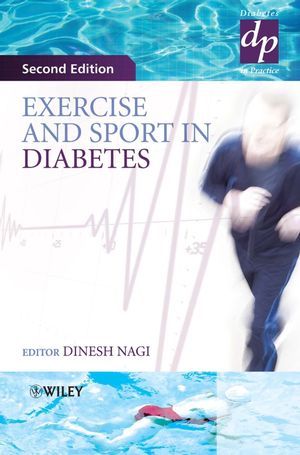Exercise and Sport in Diabetes, 2nd EditionISBN: 978-0-470-02206-1
Hardcover
240 pages
February 2006
 |
||||||
Preface to the First Edition.
Preface to the Second edition.
1 Physiological responses to exercise (Clyde Williams).
1.1 Introduction.
1.2 Maximal exercise.
1.3 Submaximal exercise.
1.4 Endurance training.
1.5 Muscle fibre composition.
1.6 Muscle metabolism during exercise.
1.7 Anaerobic and lactate thresholds.
1.8 Fatigue and carbohydrate metabolism.
1.9 Carbohydrate nutrition and exercise.
1.10 Fluid intake before exercise.
1.11 Summary.
References.
2 Exercise in type 1 diabetes (Jean-Jacques Grimm).
2.1 Introduction.
2.2 Exercise physiology.
2.3 Insulin absorption.
2.4 Hypoglycaemia.
2.5 Hyperglycaemia.
2.6 Strategy for treatment adjustments.
2.7 Evaluation of the intensity and duration of the effort.
2.8 Nutritional treatments and adaptations.
2.9 Insulin dose adjustment.
2.10 Conclusions.
References.
3 Diet and nutritional strategies during sport and exercise in type 1 diabetes (Elaine Hibbert-Jones and Gill Regan).
3.1 What is exercise?.
3.2 The athlete with diabetes.
3.3 Nutritional principles for optimizing sports performance.
3.4 Puttting theory into practice.
3.5 Identifying nutritional goals.
3.6 Energy.
3.7 Carbohydrate.
3.8 Guidelines for carbohydrate intake before, during and after exercise.
3.9 Protein.
3.10 Fat.
3.11 Vitamins and minerals.
3.12 Fluid and hydration.
3.13 Pulling it all together.
References.
Appendices.
4 The role of physical activity in the prevention of type 2 diabetes (Dinesh K. Nagi).
4.1 Exercise and prevention of type 2 diabetes.
References.
5 Exercise, metabolic syndrome and type 2 diabetes (Dinesh K. Nagi).
5.1 Physical activity in type 2 diabetes.
5.2 Type 2 diabetes, insulin resistance and the metabolic syndrome.
5.3 Effect of exercise on the metabolic syndrome of type 2 diabetes.
5.4 What kind of exercise, aerobic or resistance training.
5.5 Effects on cardiovascular risk factors.
5.6 Regulation of carbohydrate metabolism during exercise in type 2 diabetes.
5.7 Effect of physical activity on insulin sensitivity.
References.
6 The role of exercise in the management of type 2 diabetes (Dinesh K. Nagi).
6.1 Introduction.
6.2 Benefits of regular physical activity in type 2 diabetes.
6.3 Effects on long-term mortality.
6.4 Risks of physical activity.
6.5 Conclusions.
References.
7 Exercise in children and adolescents (Diarmuid Smith, Alan Connacher, Ray Newton and Chris Thompson).
7.1 Introduction.
7.2 Metabolic effects of exercise.
7.3 Attitudes to exercise in young adults with type 1 diabetes.
7.4 The Firbush camp.
7.5 Precautions during exercise.
7.6 Summary.
References.
8 Insuling pump therapy and exercise (Peter Hammond and Sandra Dudley).
8.1 Introduction.
8.2 Potential advantages of CSII.
8.3 CSII usage.
8.4 Benefits of CSII over multiple daily injections.
8.5 Potential advantages for CSII use with exercise.
8.6 Studies of response to exercise in CSII users.
8.7 Practicalities for using CSII with exercise.
8.8 Cautions for using CSII with exercise.
References.
9 Diabetes and the marathon (Bill Burr).
9.1 Introduction.
9.2 Guidelines.
9.3 Personal views.
9.4 Summary.
Bibliography.
Useful Addresses.
10 Diabetes and specific sports (Mark Sherlock and Chris Thompson).
10.1 General principles.
10.2 Canoeing.
10.3 Golf.
10.4 Hillwalking.
10.5 Extreme altitude mountaineering.
10.6 Rowing.
10.7 Soccer and rugby.
10.8 Tennis.
10.9 Sub-aqua (scuba) diving.
10.10 Skiing.
10.11 Restrictions imposed by sports governing bodies.
10.12 Conclusions.
References.
11 Becoming and staying physically active (Elizabeth Marseden and Alison Kirk).
11.1 Recommendations for physical activity and exercise.
11.2 Essential attributes of a physical activity programme for people with diabetes.
11.3 Preparation for exercise.
11.4 Changing behaviour.
References.
Appendix 1: Stretching exercises.
Appendix 2: Muscular endurance exercises.
12 The role of the diabetes team in promoting physical activity (Dinesh Nagi and Bill Burr).
12.1 Introduction.
12.2 Educating the diabetes team.
12.3 Exercise therapist as part of the team.
12.4 Assessment of patients.
12.5 The exercise prescription.
12.6 Patient education.
12.7 Motivating patients and changing behaviour.
12.8 Conclusions.
References.
Index.



